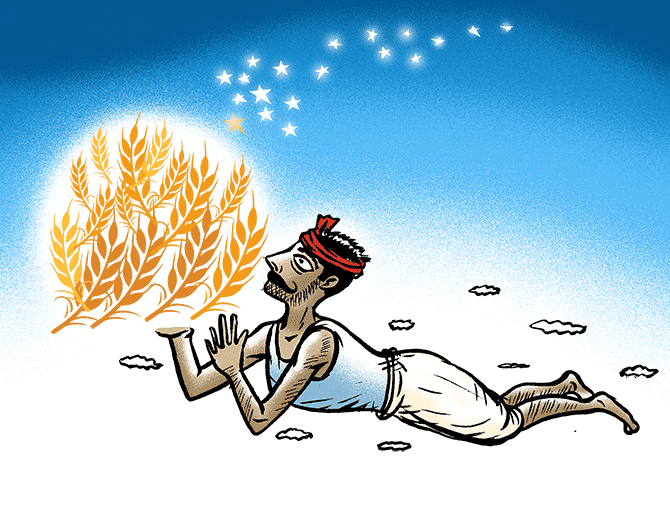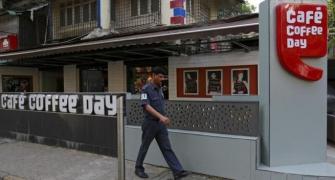Officials said good rain in August - though it might not improve acreages much for most crops except urad, moong, and paddy - would help in improving yields in the crops already planted.
Illustration: Dominic Xavier/Rediff.com

The India Meteorological Department (IMD) in its forecast for the second half of the monsoon has said rain in August and September is expected to be 100 per cent of the Long-Period Average (LPA).
This will be a big relief for farmers.
The LPA for August and September, the last two months, of the southwest monsoon season is around 42.83 cm, which is 49 per cent of the precipitation from June to September, which is estimated at 89 cm.
The Met said rain in August was expected to be 99 per cent of the LPA.
Both the forecasts have set a model error of plus and minus 8 per cent and 9 per cent, respectively.
The Met also retained its monsoon forecast at 96 per cent of the LPA, which is normal.
“Currently, the sea surface temperatures (SSTs) as well as the atmospheric conditions over the equatorial Pacific Ocean indicate El Nino Southern Oscillation (ENSO) neutral to borderline El Niño conditions.
"The latest forecasts indicate that these conditions are likely to continue during the remaining part of the monsoon season,” the Met said.
This should come as a big relief to farmers.
Rain in June was almost 33 per cent less than normal, which is among its worst performances in the past five years.
The amount of rain was small because the monsoon arrived late in several states and set in over the Kerala coast with a time lag owing to cyclone ‘VAYU’ and its after-effects.
A big monsoon break in August and September would have spelled havoc for the already delayed kharif crops and affected their yields.
Officials said good rain in August - though it might not improve acreages much for most crops except urad, moong, and paddy - would help in improving yields in the crops already planted.
“In the case of arhar, I don’t see any big improvement in acreage because in most places sowing is over, but the showers should boost the acreage of urad and moong, which are usually planted in late July and early August,” N P Singh of the Indian Institute of Pulses Research, Kanpur, told Business Standard.
He said the moong acreage would go up owing to good rain in the latter half of the monsoon because it was a short-duration crop and matured in 60-65 days.
“In places where farmers could not plant arhar, they could go for moong and urad,” Singh said.
The data sourced from the department of agriculture shows that till July 26, because of the delayed onset of the monsoon in several rainfed areas, pulses were sown in around 8.29 million hectares, which was around 18.58 per cent lower than in the same period last year.
The biggest drop was in the area under moong and arhar, where the acreages fell by 24.74 per cent and 14.73 per cent, respectively, till July 26 as compared to the same period last year.
"These acreage numbers will change in the days to come,” Singh said.
All kharif crops have been sown in around 68.87 million hectares till last week, which was 6.43 per cent less than last year and 7.87 per cent less than the normal acreage, which is the average for the last five years.
“Not only pulses, even paddy will benefit due to the late surge in rain while in South and Central India good late monsoon could translate into healthy rabi crops,” said P K Joshi, former director of the International Food Policy Research Institute (IFPRI).
“Farmers may opt to take advantage of this pickup in rainfall to sow short-duration crops ... However, the late pickup in sowing is likely to weigh upon yields.
"This may also have some impact on food prices, which is an emerging concern related to the outlook for food inflation,” ICRA said in a report.
Shubhada Rao, chief economist, YES Bank in a note said if the pace of rain sustained through much of August, there is a likelihood that for the season as a whole, there could be only a minor miss in precipitation vis-à-vis the Met’s forecast of a 4 per cent deficiency.
Since July the rains picked up pace and covered the country faster than expected.
The deficit narrowed to 9 per cent by the end of July. Experts said this deficit might disappear in the next few weeks.
The improvement in rain boosted the water level in the 91-odd reservoirs of the country from 26.94 billion cubic metres (BCM) in July 2004 to 40.83 BCM in July 2019, an increase of 53 per cent in less than a month.










